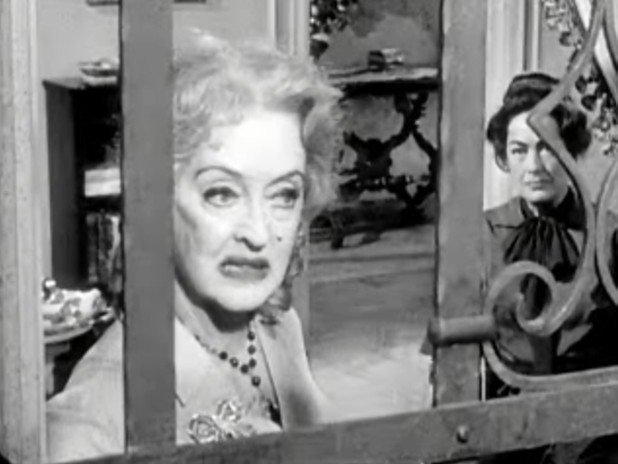So begins one of the best character introductions in cinema history. Sunset Blvd. is arguably one of the first psycho biddy films, but it also has the distinctions of being one of the most acclaimed films ever. Everything about Gloria Swanson’s Norma Desmond, a “faded star of yesteryear,” and her quest to return to the screen as a middle aged Salome is perfectly realized, down to the Salome metaphor, which leads to one of the best final scenes ever to be committed to celluloid. Although we don’t literally get to see her kissing the severed head of John the Baptist, the central mystery of the film (who is that corpse in the pool?) and stunning noir cinematography are their own dark reward.
Whatever Happened to Baby Jane? (1962)
Blanche: You wouldn’t be able to do these awful things to me if I wasn’t in this chair.
Jane: (pause) Butcha are, Blanche! Ya are in that chair!
If the above line is unfamiliar to you, you are likely not gay. Whatever Happened to Baby Jane brought together two of the most famous icons in Hollywood history, Bette Davis as former child star “Baby” Jane Hudson and Joan Crawford as her former screen siren sister Blanche, and let them reign havoc on one another. The two actresses famously did not care for one another and rumors of aggression and post-production feuds continue to surround the film. Of course, that’s part of it all. Watching Davis physically terrorize a wheelchair bound Crawford acquired an added dimension of horror/humor with the revelations in Christina Crawford’s tell-all Mommie Dearest that her mother Joan was a child abuser who famously beat her with wire hangers.
Hush, Hush Sweet Charlotte (1964)
Miriam: Why wouldn’t I tell him that his pure, darling little girl was having a dirty little affair with a married man?
Charlotte: You’re a vile, sorry little bitch!
Hush, Hush Sweet Charlotte was supposed to be the re-pairing of Bette Davis and Joan Crawford after the huge success of Baby Jane, but, in this case, the story behind the scenes is just as scary as the one on it. Allegedly, Davis made it her mission to terrorize Crawford until Mommie Dearest was forced to quit the film and was replaced by Davis’s friend Olivia de Havilland. Charlotte tells the southern Gothic story of the once aristocratic Hollis family and how the ghosts of a murder in Charlotte’s (Bette Davis, in the role of heroine, not villain unlike Baby Jane) past haunt the family plantation on the eve of its demolition. Even scarier than Baby Jane, the film still has plenty of quotable camp moments and you cannot miss Agnes Moorehead (Endora from television’s Bewitched) as the hillbilly butch housekeeper who may or may not have a little crush on Charlotte.
Misery (1990)
Annie: [Right after smashing Paul’s ankles with a sledgehammer] God I love you.
Kathy Bates rightly won an Oscar for her deeply scary performance as Annie Wilkes in Stephen King’s Misery. When Paul (James Caan), a writer who has just killed off the lead in his popular series, crashes his car in a rural blizzard and is rescued by his “biggest fan” Annie, you can guess she has a few thoughts of her own on the death of a character she deeply loves. Annie’s solution? Get Paul to write the character back to life by keeping him prisoner in her guestroom! As a writer, it kind of makes you afraid of your readers… just kidding (maybe!). The legendary “hobbling” scene still deserves screams, even after repeat viewings.
Hush (1998)
Martha: I want this lying bitch out of my house!
Helen: There’s only room for one of those.
Back when series one of American Horror Story aired and everyone was in shocked awe of Jessica Lange’s performance as a murderous, Southern mother from belle hell, I wasn’t the least surprised. Lange’s role as Kentucky matriarch Martha Baring in Hush (opposite Gwyneth Paltrow as her besieged Yankee daughter-in-law) was a fine foreshadowing of her award winning work on Ryan Murphy’s anthology series. Okay, part of the fun is watching Miss Goop get the living hell scared out of her by Lange, but the other part of the fun is watching Lange swallow the scenery whole; there’s absolutely no chewing involved here. A box office failure at the time, Hush is due for a revival.
Monster (2003)
Aileen: I’m not a bad person. I’m a real good person.


